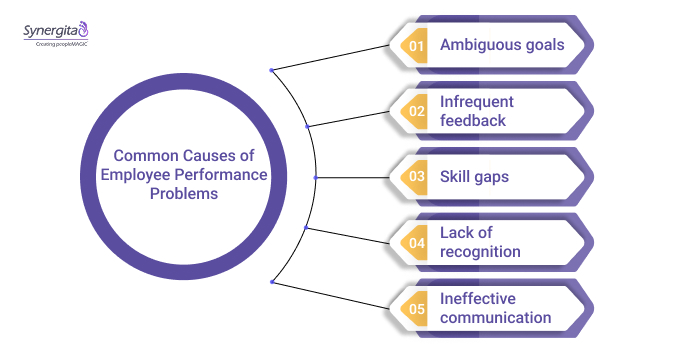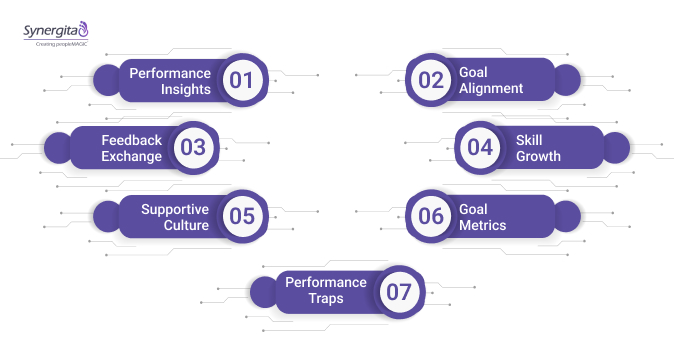Unlocking your team’s true potential requires more than just meeting deadlines; it demands a systematic approach to workplace improvement that aligns clear goals, encourages ongoing feedback, and supports continuous development.
With 85% of employees saying clearer goals and better feedback boost performance, the real challenge lies in achieving alignment and sustained growth. This guide shares effective strategies proven to help you improve employee performance and drive measurable business results.
Key Takeaways
- Clear goals help guide employee efforts and ensure everyone is working toward the same objectives.
- Regular, constructive feedback motivates employees and drives continuous improvement.
- Investing in ongoing skill development empowers teams to adapt to changing business needs.
- Recognizing achievements boosts morale and helps retain top performers.
- Open communication channels minimize misunderstandings and keep workflows efficient.
- Real-time analytics enable managers to monitor progress and make better decisions swiftly.
What Is Employee Performance?
Employee performance is the consistent delivery of results that drive business impact, including completing tasks, reaching targets, and growing capabilities in sync with organizational needs. It’s more than productivity; it’s about the quality, efficiency, and strategic value each person brings to the team.
How Do You Define High Performance?
High-performing employees consistently:
- Complete tasks ahead of schedule.
- Surpass personal and team goals.
- Actively seek and apply feedback.
- Drive innovation and collaborate seamlessly.
- Take ownership and support colleagues.
This isn’t just about output; it’s about adaptability, contribution to business goals, and willingness to learn.

Common Causes of Employee Performance Problems

Before you can improve employee performance, diagnose the issues:
- Ambiguous goals: Teams working without clear expectations often struggle to meet deadlines and deliver results.
- Infrequent feedback: Annual reviews alone can leave employees disengaged.
- Skill gaps: Fast-changing roles require ongoing learning.
- Lack of recognition: When employees don’t feel valued, engagement drops. Strong recognition programs can reduce voluntary turnover by up to 31%, highlighting their role in retaining top talent.
- Ineffective communication: Information bottlenecks disrupt workflows.
Steps and Strategies to Improve Employee Performance

Improving employee performance requires a structured approach that combines clear goals, continuous feedback, and a supportive culture. The following steps outline practical strategies to help organizations foster high performance and sustained growth.
Step 1: Understanding Employee Performance
Effective performance management drives engaged, high-performing teams. Continuous feedback fuels better employee engagement and business outcomes compared to annual reviews.
Step 2: Strategic Goal Alignment
When employees’ daily tasks clearly support the company’s bigger goals, the impact grows. Goals give purpose to every activity and help teams stay focused. Using tools like OKRs or project-based trackers boosts transparency and accountability. Synergita’s OKR module makes it easy to align goals visually and uses AI assistance to keep everyone on track.
When comparing performance management methods, structured OKRs offer distinct advantages over traditional task tracking or manual reviews:
| Performance Factor | Teams Using OKRs | Teams Using Traditional Task Tracking / Manual Reviews |
| Goal Clarity and Alignment | Clear, measurable objectives aligned across teams | Often vague, siloed goals without clear company alignment |
| Feedback Frequency | Continuous, real-time feedback and progress checks | Infrequent, usually annual or bi-annual reviews |
| Employee Engagement | Higher engagement; up to 30-40% increase reported | Lower engagement; relies on static, infrequent feedback |
| Performance Transparency | High transparency with shared goals and outcomes | Limited visibility into progress and impact |
| Adaptability and Agility | Agile goal adjustment quarterly or as needed | Rigid goals set annually, slow to adapt to change |
| Outcome Focus | Focus on measurable business outcomes | Focus on task completion, less strategic impact tracking |
| Turnover Impact | Reduced turnover linked to clear goals and engagement | Higher turnover due to disengagement and unclear expectations |
This comparison highlights why adopting OKRs can lead to better alignment, engagement, and adaptability, setting the stage for more effective feedback and communication.
Step 3: Feedback and Communication
Constructive feedback fuels ongoing growth and engagement. Using a continuous feedback tool enables timely coaching and regular communication. Automated reminders make feedback a natural part of team culture, promoting collaboration.
Step 4: Continuous Skill Development
Upskilling is essential for long-term success. Providing tailored learning paths, online resources, and real-time performance data helps employees quickly close skill gaps. Digital platforms allow learning when it’s needed most, keeping growth on track. Integration with learning and HR systems makes skill tracking and development seamless.
Step 5: Building a Supportive Culture
Employee performance thrives in cultures valuing recognition, safety, and transparency. Authentic leaders inspire teams, and peer recognition builds trust. Gallup and Workhuman found that well-recognized employees are 45% less likely to leave within two years, highlighting recognition’s role in retention. Synergita supports culture scoring and recognition programs to boost motivation and teamwork.
Step 6: Effective Use of Goal Setting and Metrics
Clear, measurable goals are essential for success. Key metrics like productivity, customer satisfaction, and project completion add objectivity to performance reviews. Combined with regular feedback, these data help managers get a complete picture and make informed decisions. Real-time dashboards bring all this information together for easy tracking.
Step 7: Avoiding Common Performance Pitfalls
Micromanaging kills creativity and limits employee freedom. Focus on outcomes and empower teams to own their work. Setting realistic deadlines helps prevent burnout. Configurable workflows support autonomy while keeping everyone aligned and accountable.
How Synergita Can Help Improve Employee Performance
Modern performance management requires more than just annual reviews—it needs continuous feedback, strategic goal alignment, and data-driven insights. Synergita offers an integrated performance management system designed to enhance employee performance at every level. Key benefits include:
- Dynamic OKR software with AI-powered tools to set, track, and cascade meaningful goals across teams.
- Seamless team goal tracking with real-time dashboards and progress monitoring.
- Automated reminders and coaching through a continuous feedback tool.
- Integrations like Jira OKR integration that connect daily work with strategic planning.
Ready to turn scattered efforts into strategic success? Start your free trial with Synergita today and see how Synergita’s AI-powered OKR alignment can transform scattered efforts into focused, strategic growth. Don’t let your competitors stay ahead—keep your teams aligned, motivated, and driving measurable business results.
Explore our resources on goal-setting strategies and learn how industry leaders are winning with systematic OKR alignment.

FAQs on Improving Employee Performance
1. Why is recognition important for performance?
Recognition boosts motivation, engagement, and retention by making employees feel valued for their contributions.
2. What role do skill development and training play?
Ongoing skill development ensures employees adapt to changing roles and remain effective in their positions.
3. How does goal alignment impact employee performance?
When employees see how their work contributes to broader company objectives, their motivation and productivity increase.
4. How often should managers give feedback?
Frequent, timely feedback—ideally on a continuous or monthly basis—helps employees stay engaged and aligned.

